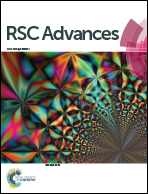ε-Caprolactone-based solid polymer electrolytes for lithium-ion batteries: synthesis, electrochemical characterization and mechanical stabilization by block copolymerization†
Abstract
In this work, three types of polymers based on ε-caprolactone have been synthesized: poly(ε-caprolactone), polystyrene-poly(ε-caprolactone), and polystyrene-poly(ε-caprolactone-r-trimethylene carbonate) (SCT), where the polystyrene block was introduced to improve the electrochemical and mechanical performance of the material. Solid polymer electrolytes (SPEs) were produced by blending the polymers with 10–40 wt% lithium bis(trifluoromethane)sulfonimide (LiTFSI). Battery devices were thereafter constructed to evaluate the cycling performance. The best performing battery half-cell utilized an SPE consisting of SCT and 17 wt% LiTFSI as both binder and electrolyte; a Li|SPE|LiFePO4 cell that cycled at 40 °C gave a discharge capacity of about 140 mA h g−1 at C/5 for 100 cycles, which was superior to the other investigated electrolytes. Dynamic mechanical analysis (DMA) showed that the storage modulus E’ was about 5 MPa for this electrolyte.



 Please wait while we load your content...
Please wait while we load your content...